A Simulation Study on Optimization of Sowing Time of Maize (Zea mays L.) for Maximization of Growth and Yield in the Present Context of Climate Change under the North China Plain
Abstract
:1. Introduction
2. Material and Methods
2.1. Study Site
2.2. Experimental Design
2.3. Data Sources
2.4. Data Analysis
- (1)
- Reproduction period
- (2)
- Solar radiation
- (3)
- Potential photosynthetic productivity
- (4)
- Light-temperature potential productivity
- (5)
- Accumulated temperature model
- (a)
- The growth rate increases with increasing temperature after the temperature reaches the lower limit of crop growth and development and is relatively stable, which can be calculated as follows:
- (b)
- Shen [36] believed that there was a nonlinear relationship between crop growth rate and temperature given the effectiveness of three base temperatures for crop development, which can be calculated using Equation (11):
3. Results
3.1. Change of Climate Resources
3.2. Analysis of Growth Process and Light-Temperature Resources in Different Stages
3.3. Relationship between Light-Temperature Potential Yield and Yield
3.4. Analysis of Suitable Sowing Date of Maize
4. Discussion
4.1. Sowing Date affects Maize Growth Stage by Changing the Availability of the Light and Temperature Resources
4.2. VGP had a Stronger Effect on Maize Yield Than RGP
4.3. Measures for Adapting Maize Production to Climate Change
4.4. Future Scope of Research
5. Conclusions
Author Contributions
Funding
Institutional Review Board Statement
Informed Consent Statement
Data Availability Statement
Acknowledgments
Conflicts of Interest
References
- National Bureau of Statistics of China. China Statistical Yearbook; China Statistic Press: Beijing, China, 2021. (In Chinese)
- United Nation, Department of Economic and Social Affairs, P.D. World Population Prospects 2022: Ten Key Messages. Available online: https://population.un.org/wpp/Publications (accessed on 30 July 2022).
- IPCC. Climate Change 2021: The Physical Science Basis. Contribution of Working Group I to the Sixth Assessment Report of the Intergovernmental Panel on Climate Change; Cambridge University Press: Cambridge, UK, 2021.
- Duan, J.; Yuan, J.; Xu, X.; Ju, H. Interpretation of the IPCC AR6 report on agricultural systems. Clim. Chang. Res. 2022, 18, 1673–1719. (In Chinese) [Google Scholar]
- Kamali, B.; Abbaspour, K.C.; Wehrli, B.; Yang, H. Drought vulnerability assessment of maize in Sub-Saharan Africa: Insights from physical and social perspectives. Glob. Planet. Chang. 2018, 162, 266–274. [Google Scholar] [CrossRef] [Green Version]
- Heim, R.R. A Comparison of the Early 21st Century Drought in the USA to the 1930s and 1950s Drought Episodes. Bull. Am. Meteorol. Soc. 2017, 98, 2579–2592. [Google Scholar] [CrossRef]
- Zhang, J.; Liu, Y. Decoupling of impact factors reveals the response of cash crops phenology to climate change and adaptive management practice. Agr. For. Meteorol. 2022, 322, 109010. [Google Scholar] [CrossRef]
- Yan, P.; Chen, Y.; Sui, P.; Vogel, A.; Zhang, X. Effect of maize plant morphology on the formation of apical kernels at different sowing dates and under different plant densities. Field Crop. Res. 2018, 223, 83–92. [Google Scholar] [CrossRef]
- Huang, M.; Shan, S.; Zhou, X.; Chen, J.; Cao, F.; Jiang, L.; Zou, Y. Leaf photosynthetic performance related to higher radiation use efficiency and grain yield in hybrid rice. Field Crop. Res. 2016, 193, 87–93. [Google Scholar] [CrossRef]
- Nasim, W.; Belhouchette, H.; Ahmad, A.; Habib-Ur-Rahman, M.; Jabran, K.; Ullah, K.; Fahad, S.; Shakeel, M.; Hoogenboom, G. Modelling climate change impacts and adaptation strategies for sunflower in Pakistan. Outlook Agric. 2016, 45, 39–45. [Google Scholar] [CrossRef]
- Zhang, Y.; Zhang, L.; Yang, N.; Huth, N.; Wang, E.; van der Werf, W.; Evers, J.B.; Wang, Q.; Zhang, D.; Wang, R.; et al. Optimized sowing time windows mitigate climate risks for oats production under cool semi-arid growing conditions. Agr. For. Meteorol. 2019, 266–267, 184–197. [Google Scholar] [CrossRef]
- Xu, K.; Sun, Z.; Huo, Z.Y.; Dai, Q.G.; Zhang, H.C.; Liu, J.; Song, Y.S.; Yang, D.L.; Wei, H.Y.; Wu, A.G.; et al. Effects of Seeding Date and Variety Type on Yield, Growth Stage and Utilization of Temperature and Sunshine in Rice. Sci. Agric. Sin. 2013, 46, 4222–4233. (In Chinese) [Google Scholar] [CrossRef]
- Owusu, E.S.; Bravo-Ureta, B.E. Reap when you sow? The productivity impacts of early sowing in Malawi. Agr. Syst. 2022, 199, 103412. [Google Scholar] [CrossRef]
- Zhong, X.Y.; Li, Q.P.; Yang, F.; Chen, D.; He, L.H.; Yang, Z.P.; Wu, Z.Y.; Lu, H.; Li, Z.Z.; Zeng, Y.L. Higher solar radiation and lower temperature enhance biomass production and grain yield of rice under high-altitude condition. Arch. Agron. Soil Sci. 2021, 68, 1664–1680. [Google Scholar] [CrossRef]
- Amas, J.I.; Fernandez, J.A.; Curin, F.; Cirilo, A.G.; Ciampitti, I.A.; Otegui, M.E. Maize genetic progress in the central Pampas of Argentina: Effects of contrasting sowing dates. Field Crop. Res. 2022, 281, 108492. [Google Scholar] [CrossRef]
- Wang, J.; Wang, E.; Yang, X.; Zhang, F.; Yin, H. Increased yield potential of wheat-maize cropping system in the North China Plain by climate change adaptation. Clim. Chang. 2012, 113, 825–840. [Google Scholar] [CrossRef]
- Collins, B.; Chenu, K. Improving productivity of Australian wheat by adapting sowing date and genotype phenology to future climate. Clim. Risk Manag. 2021, 32, 100300. [Google Scholar] [CrossRef]
- Liu, Z.; Hubbard, K.G.; Lin, X.; Yang, X. Negative effects of climate warming on maize yield are reversed by the changing of sowing date and cultivar selection in Northeast China. Glob. Chang. Biol. 2013, 19, 3481–3492. [Google Scholar] [CrossRef] [PubMed]
- Zhu, G.; Liu, Z.; Qiao, S.; Zhang, Z.; Huang, Q.; Su, Z.; Yang, X. How could observed sowing dates contribute to maize potential yield under climate change in Northeast China based on APSIM model. Eur. J. Agron. 2022, 136, 126511. [Google Scholar] [CrossRef]
- Lv, Z.; Li, F.; Lu, G. Adjusting sowing date and cultivar shift improve maize adaption to climate change in China. Mitig. Adapt. Strateg. Glob. Chang. 2019, 25, 87–106. [Google Scholar] [CrossRef]
- Guo, Y.; Lu, X.; Zhang, J.; Li, K.; Tong, Z. Joint analysis of drought and heat events during maize (Zea mays L.) growth periods using copula and cloud models: A case study of Songliao Plain. Agr. Water Manag. 2022, 259, 107238. [Google Scholar] [CrossRef]
- Sharma, R.C. Duration of the vegetative and reproductive period in relation to yield performance of spring wheat [vegetative growth period, grain filling period]. Eur. J. Agron. 1992, 1, 133–137. [Google Scholar] [CrossRef]
- Chen, J.; Ren, B.; Zhao, B.; Liu, P.; Yang, J. Determination on Suitable Sowing Date of Summer Maize Hybrids Based on Effective Accumulated Temperature in Growth Period. Agric. Sin. 2021, 54, 3632–3646. (In Chinese) [Google Scholar] [CrossRef]
- Zhan, W.; Zhang, J.; Yuan, J.; Liang, Y.; Cheng, S.; Zhang, S.; Ren, J.; Liu, J.; Cai, H. Adjusting sowing dates enhance the efficiency of climate and nutrient resources for spring maize. J. Plant Nutr. Fertil. 2021, 27, 1725–1734. (In Chinese) [Google Scholar] [CrossRef]
- Shao, R.X.; Kang-Ke, Y.U.; Hong-Wei, L.I.; Jia, S.J.; Yang, Q.H.; Zhao, X.; Zhao, Y.L.; Liu, T.X. The effect of elevating temperature on the growth and development of reproductive organs and yield of summer maize. J. Integr. Agr. 2021, 259, 107238. [Google Scholar] [CrossRef]
- Cheabu, S.; Moung-Ngam, P.; Arikit, S.; Vanavichit, A.; Malumpong, C. Effects of Heat Stress at Vegetative and Reproductive Stages on Spikelet Fertility. Rice Sci. 2018, 25, 218–226. [Google Scholar] [CrossRef]
- Shao, R.; Jia, S.; Tang, Y.; Zhang, J.; Zhao, X. Soil water deficit suppresses development of maize ear by altering metabolism and photosynthesis. Environ. Exp. Bot. 2021, 192, 104651. [Google Scholar] [CrossRef]
- Ataur, R.M.; Jiro, C.; Satoshi, Y.; Ajms, K. Growth and yield components of wheat genotypes exposed to high temperature stress under control environment. Bangladesh J. Agric. Res. 2009, 34, 360–372. [Google Scholar] [CrossRef] [Green Version]
- Tian, B.; Zhu, J.; Nie, Y.; Xu, C.; Meng, Q.; Wang, P. Mitigating heat and chilling stress by adjusting the sowing date of maize in the North China Plain. J. Agron. Crop. Sci. 2019, 205, 77–87. [Google Scholar] [CrossRef] [Green Version]
- Zhou, H.; Zhou, G.; He, Q.; Zhou, L.; Ji, Y.; Zhou, M. Environmental explanation of maize specific leaf area under varying water stress regimes. Environ. Exp. Bot. 2020, 171, 103932. [Google Scholar] [CrossRef]
- Angstrom, A. Solar and terrestrial radiation. Report to the international commission for solar research on actinometric investigations of solar and atmospheric radiation. Q. J. R. Meteorol. Soc. 2010, 50, 121–126. [Google Scholar] [CrossRef]
- He, Q.H.; Xie, Y. Research on the Climatological Method of Solar Radiation in China. J. Nat. Resour. 2010, 25, 308–319. (In Chinese) [Google Scholar] [CrossRef]
- Tymvios, F.S.; Jacovides, C.P.; Michaelides, S.C.; Scouteli, C. Comparative study of ngstrm’s and artificial neural networks’ methodologies in estimating global solar radiation. Sol. Energy 2005, 78, 752–762. [Google Scholar] [CrossRef]
- Han, R.Q.; Zheng, D.; Dai, E.F.; Wu, S.H. Response of Production Potential to Climate Fluctuation in Major Grain Regions of China. Resour. Sci. 2014, 36, 2611–2623. (In Chinese) [Google Scholar]
- Hou, G.L.; Liu, Y.F. Climate potential productivity and its partition in China. J. Nat. Resour. 1985, 3, 52–59. (In Chinese) [Google Scholar]
- Shen, G.Q. Model of nonlinearity temperature on developing rate of crops. Meteorol. Mon. 1980, 31, 9–11. (In Chinese) [Google Scholar] [CrossRef]
- Li, Z.; Yang, P.; Tang, H.; Wu, W.; Yin, H.; Liu, Z.; Zhang, L. Response of maize phenology to climate warming in Northeast China between 1990 and 2012. Reg. Environ. Chang. 2013, 14, 39–48. [Google Scholar] [CrossRef]
- Ioslovich, I.; Gutman, P.O. On the botanic model of plant growth with intermediate vegetative-reproductive stage. Popul. Biol. 2005, 68, 147–156. [Google Scholar] [CrossRef] [PubMed]
- Han, H.; Zhang, L.; Sun, M.; Li, J.; Chang, X.; Guo, Z.J.; Wang, X.F. Response of Growth, Development and Yield of Different Summer Maize Cultivars to Sowing Date in Huang-Huai-Hai Plain. J. Maize Sci. 2020, 28, 106–114. (In Chinese) [Google Scholar] [CrossRef]
- Gao, Z.; Feng, H.Y.; Liang, X.G.; Lin, S.; Zhou, S.L. Adjusting the sowing date of spring maize did not mitigate against heat stress in the North China Plain. Agr. For. Meteorol. 2021, 298–299, 108274. [Google Scholar] [CrossRef]
- Addy, J.; Ellis, R.H.; Macdonald, A.J.; Semenov, M.A.; Mead, A. Changes in agricultural climate in South-Eastern England from 1892 to 2016 and differences in cereal and permanent grassland yield. Agr. For. Meteorol. 2021, 308–309, 108560. [Google Scholar] [CrossRef]
- Talukder, A.S.M.H.M.; McDonald, G.K.; Gill, G.S. Effect of short-term heat stress prior to flowering and at early grain set on the utilization of water-soluble carbohydrate by wheat genotypes. Field Crop. Res. 2013, 147, 1–11. [Google Scholar] [CrossRef]
- Anwar, M.R.; Liu, D.L.; Farquharson, R.; Macadam, I.; Abadi, A.; Finlayson, J.; Wang, B.; Ramilan, T. Climate change impacts on phenology and yields of five broadacre crops at four climatologically distinct locations in Australia. Agr. Syst. 2015, 132, 133–144. [Google Scholar] [CrossRef] [Green Version]
- Zou, J.; Cui, Z.; Xu, Y.; Zhu, X. Comparison of Grain Dehydration Process and Yield Formation for Summer Maize under Different Sowing Dates in Huanghuaihai Plain. Chin. J. Agrometeorol. 2022, 43, 112–123. (In Chinese) [Google Scholar] [CrossRef]
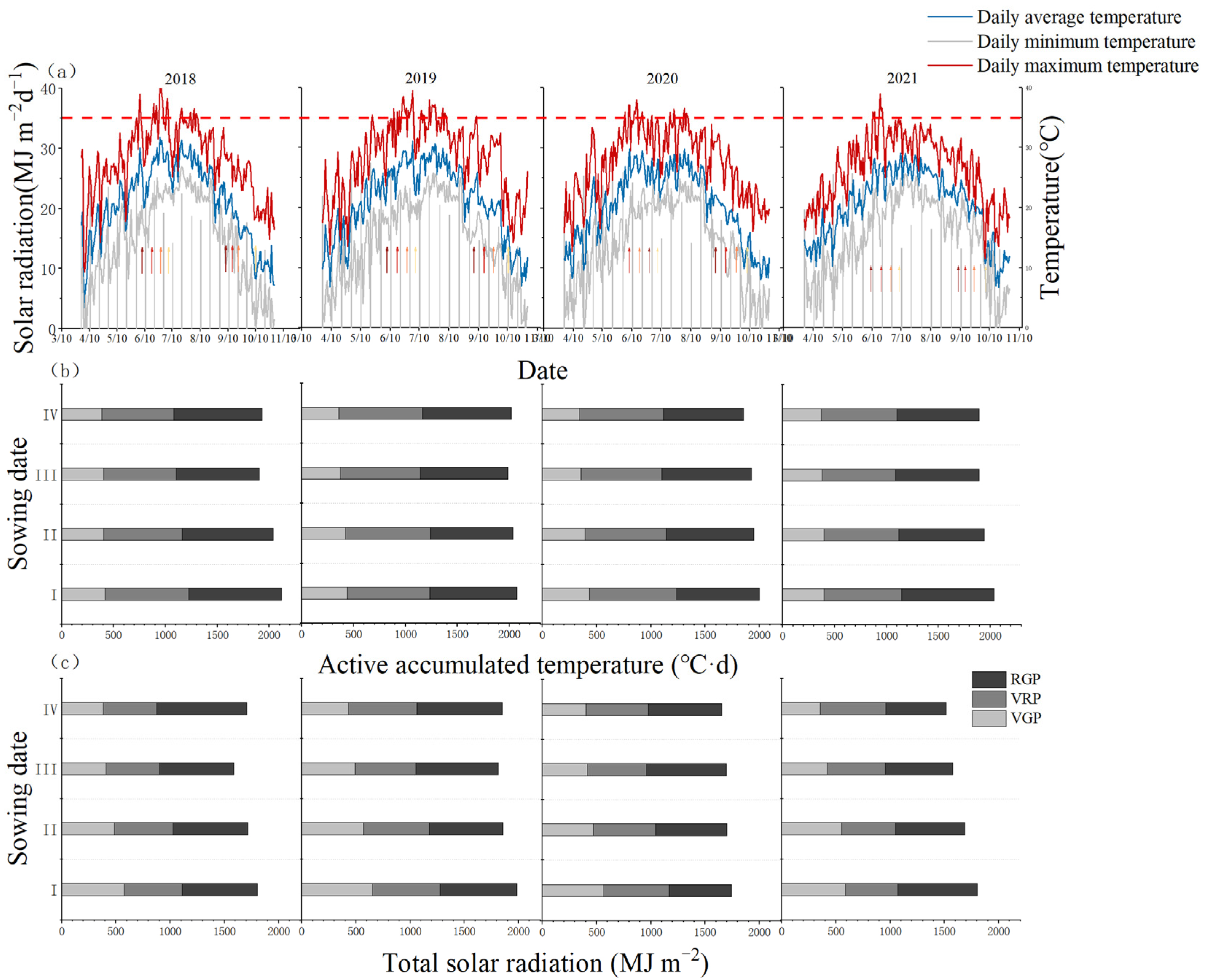
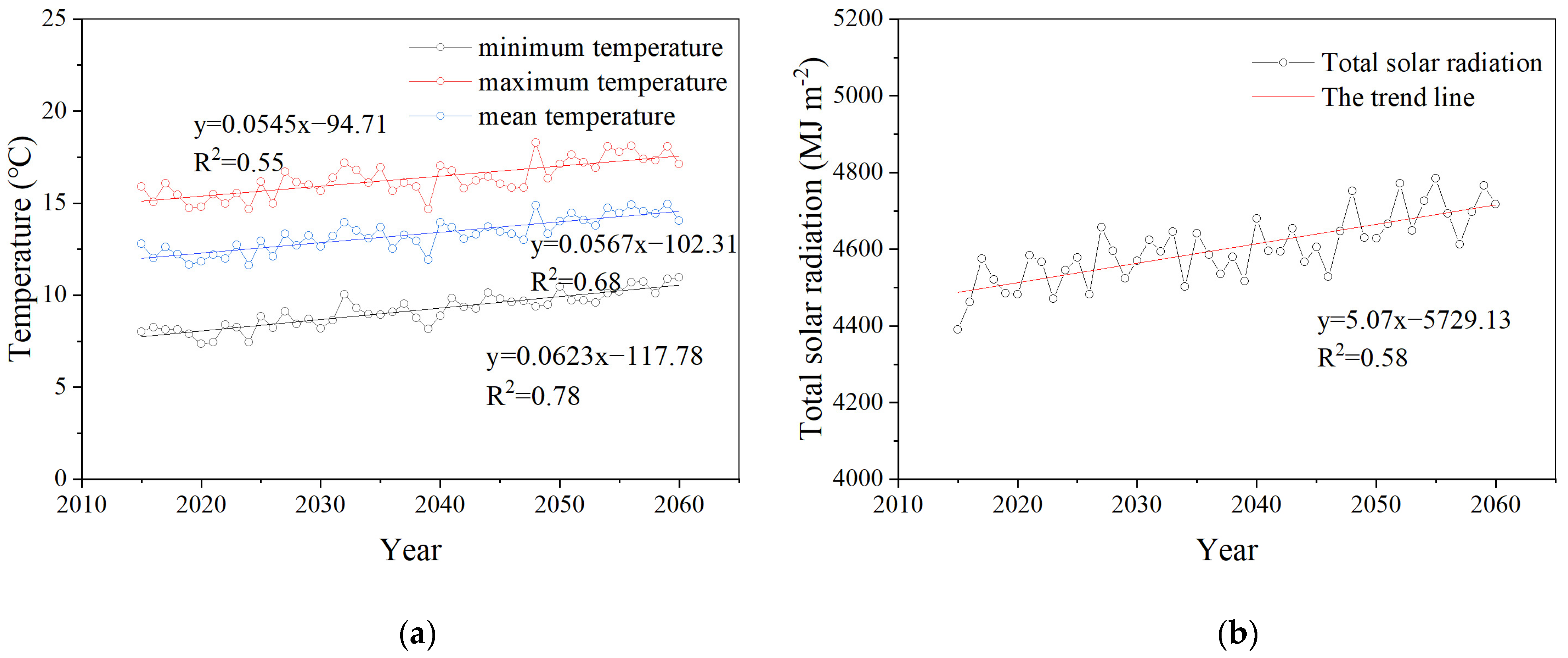
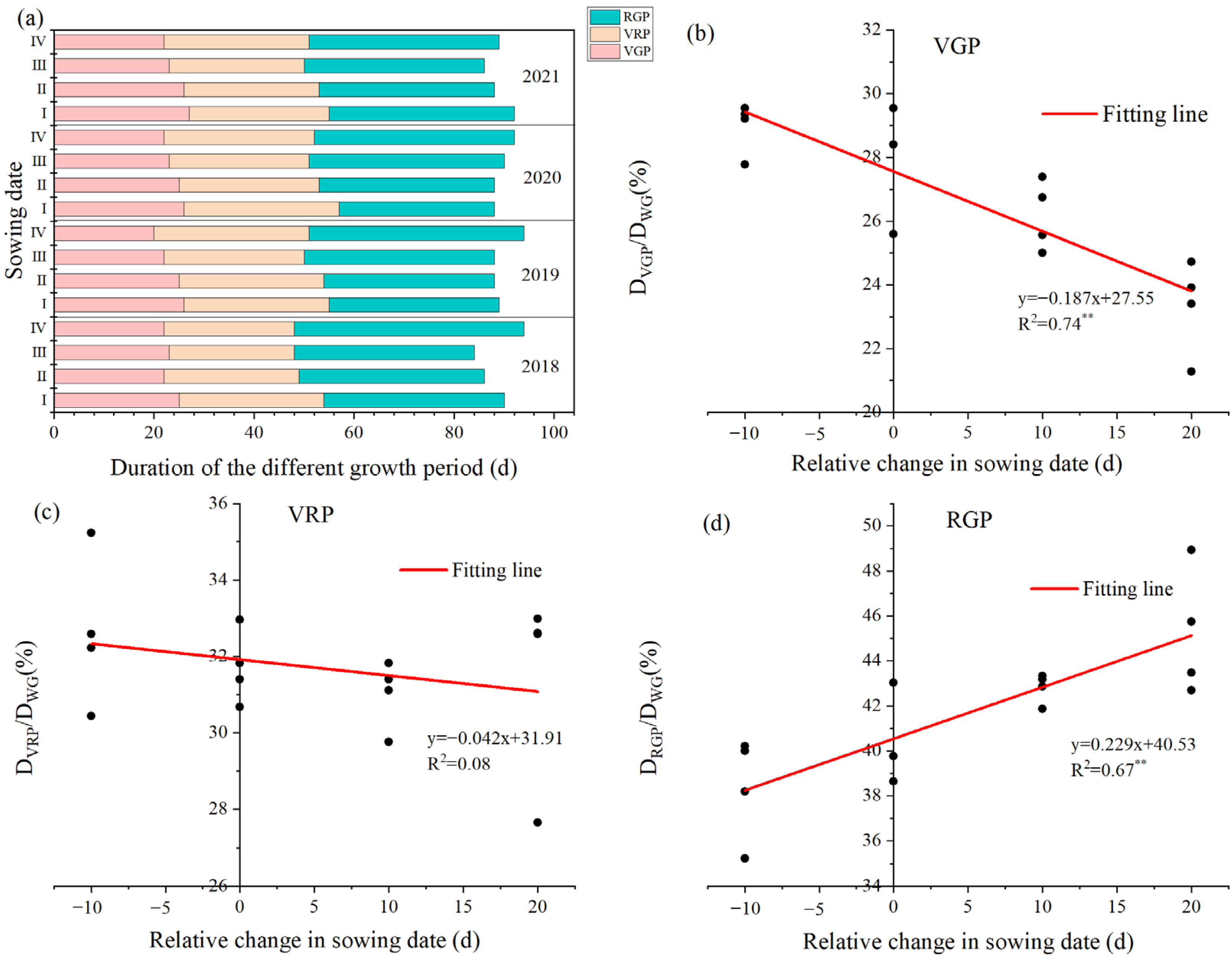
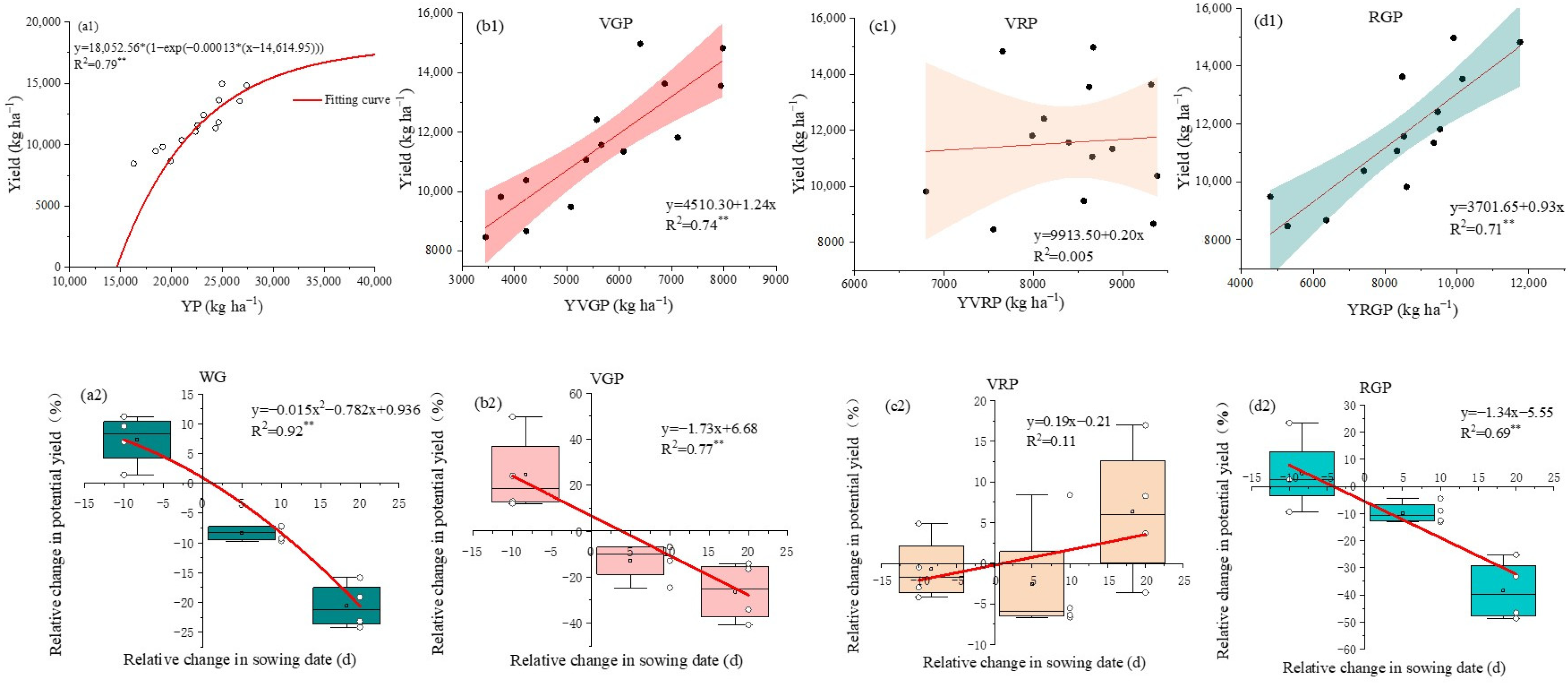
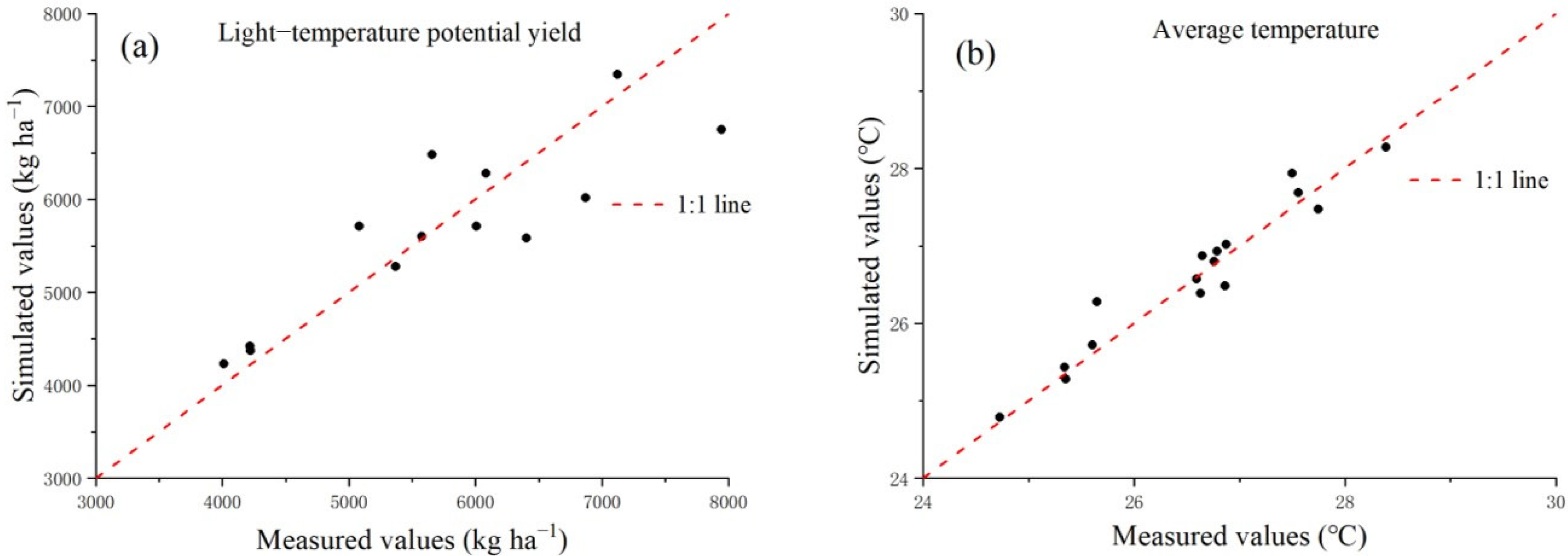
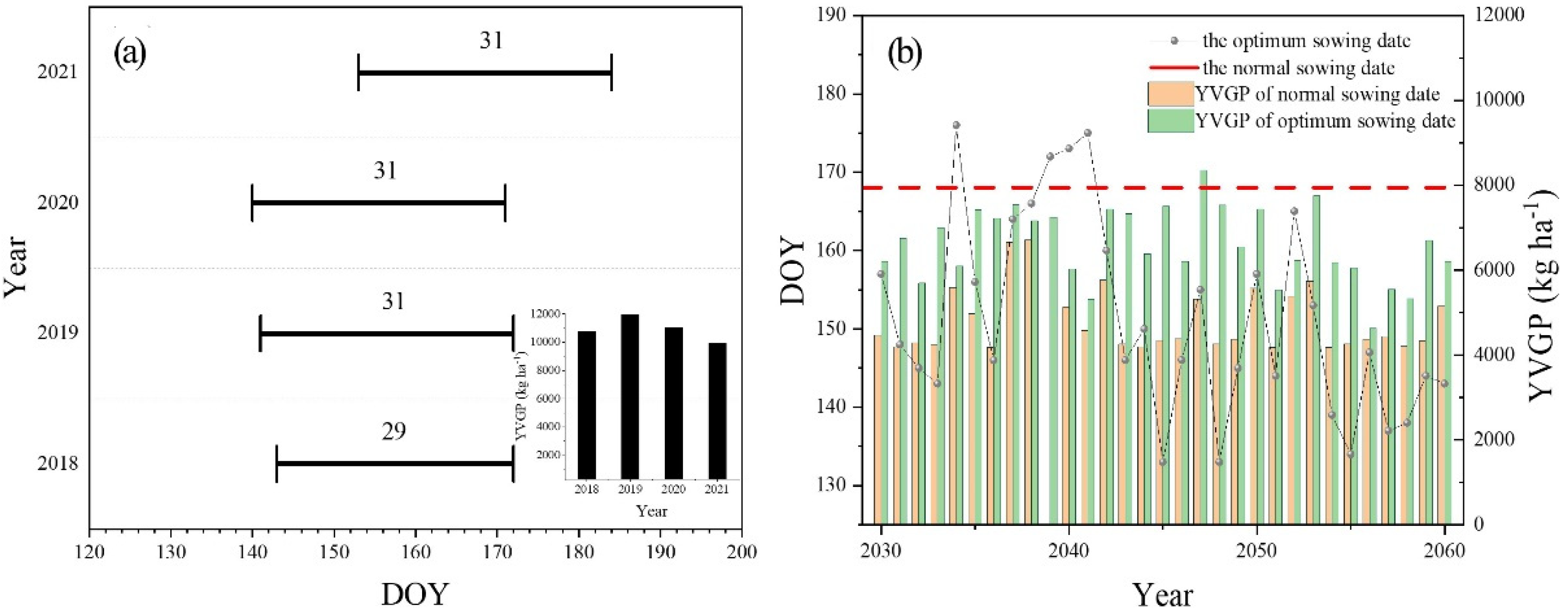
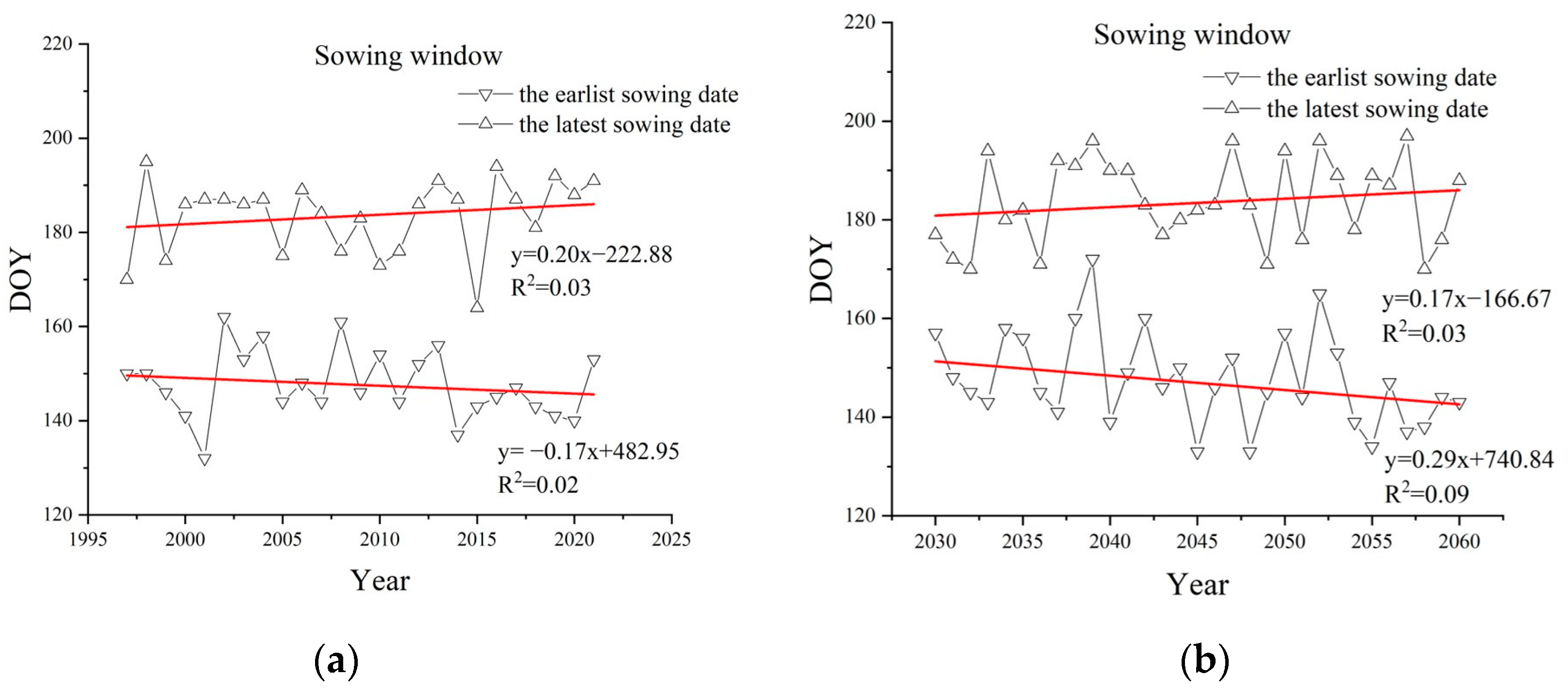
| Development Stage | Three Critical Points of Temperature (°C) | ||
|---|---|---|---|
| Tmin | Top | Tmax | |
| Sowing-jointing | 10 | 25 | 32 |
| Jointing-heading | 10 | 27 | 35 |
| Heading-maturity | 15 | 23 | 32 |
| Development Stage | Model | Sample Sizes | Determination Coefficient | Sequence Number |
|---|---|---|---|---|
| Vegetative growth period | 16 | 0.81 ** | (12) | |
| 16 | 0.80 ** | (13) | ||
| 16 | 0.80 ** | (14) | ||
| Vegetative and reproductive period | 16 | 0.51 * | (15) | |
| 16 | 0.67 ** | (16) | ||
| 16 | 0.67 ** | (17) | ||
| Reproductive growth period | 14 | 0.43 * | (18) | |
| 14 | 0.73 ** | (19) | ||
| 14 | 0.73 ** | (20) |
| Year | Sowing Date (DOY) | Actual Duration (d) | Simulated Duration (d) | Difference Value (d) | Year | Sowing Date (DOY) | Actual Duration (d) | Simulated Duration (d) | Difference Value (d) |
|---|---|---|---|---|---|---|---|---|---|
| 2018 | 158 | 25 | 22 | 3 | 2020 | 159 | 26 | 21 | 5 |
| 168 | 22 | 22 | 0 | 169 | 25 | 22 | 3 | ||
| 178 | 23 | 27 | −4 | 179 | 23 | 25 | −2 | ||
| 188 | 22 | 25 | −3 | 189 | 22 | 23 | −1 | ||
| 2019 | 158 | 26 | 21 | 5 | 2021 | 158 | 27 | 28 | −1 |
| 168 | 25 | 21 | 4 | 168 | 26 | 25 | 1 | ||
| 178 | 22 | 21 | 1 | 178 | 23 | 21 | 2 | ||
| 188 | 20 | 20 | 0 | 188 | 22 | 21 | 1 |
Disclaimer/Publisher’s Note: The statements, opinions and data contained in all publications are solely those of the individual author(s) and contributor(s) and not of MDPI and/or the editor(s). MDPI and/or the editor(s) disclaim responsibility for any injury to people or property resulting from any ideas, methods, instructions or products referred to in the content. |
© 2023 by the authors. Licensee MDPI, Basel, Switzerland. This article is an open access article distributed under the terms and conditions of the Creative Commons Attribution (CC BY) license (https://creativecommons.org/licenses/by/4.0/).
Share and Cite
Wu, Y.; Zhou, G.; Song, Y.; Ren, S.; Geng, J.; Zhao, H.; Song, X. A Simulation Study on Optimization of Sowing Time of Maize (Zea mays L.) for Maximization of Growth and Yield in the Present Context of Climate Change under the North China Plain. Agronomy 2023, 13, 385. https://doi.org/10.3390/agronomy13020385
Wu Y, Zhou G, Song Y, Ren S, Geng J, Zhao H, Song X. A Simulation Study on Optimization of Sowing Time of Maize (Zea mays L.) for Maximization of Growth and Yield in the Present Context of Climate Change under the North China Plain. Agronomy. 2023; 13(2):385. https://doi.org/10.3390/agronomy13020385
Chicago/Turabian StyleWu, Yixuan, Guangsheng Zhou, Yanling Song, Sanxue Ren, Jinjian Geng, Huarong Zhao, and Xingyang Song. 2023. "A Simulation Study on Optimization of Sowing Time of Maize (Zea mays L.) for Maximization of Growth and Yield in the Present Context of Climate Change under the North China Plain" Agronomy 13, no. 2: 385. https://doi.org/10.3390/agronomy13020385





